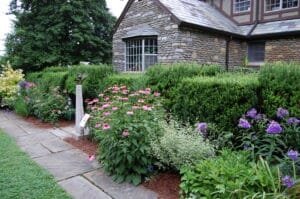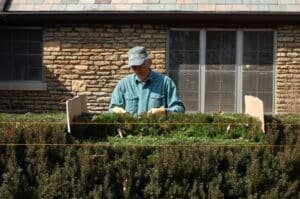Planting a hedgerow? Here are 6 tips and tricks to know about how to grow a hedge

Paul Cappiello Ph.D.
Yew Dell Botanical Gardens Executive Director
Fences make good neighbors . . . and so do hedges . . . as long as they are done well . . .
Hedges are the workhorses of the suburban garden. They define space. As superstars of the backdrop, they set the mood and tone of a garden. They keep the neighbor kid’s errant basketball from mowing down your young tomato transplants!
But there are a few basic rules to planning and maintaining your hedge to help keep you . . . and the neighbors happy.
What is a hedge?
Seems fairly obvious, but a hedge is just a linear planting of plants meant to define an edge, provide a screen or create a backdrop. Many homeowners think that hedges can only consist of boxwood, privet or arborvitae, but just about any plant that meets your size and ornamental appeal prescription can be used as a hedge: ornamental grasses, small trees . . . You can even use a line of herbs to make a small hedge. But one thing to keep in mind is that a hedge is usually most effective when all the plants are allowed to grow together into a continuous line rather than looking like a string of little green meatballs.

Hedge placement
While not a requirement of all, many hedges are placed along the property line to screen out the neighbor’s big plastic pirate ship play set or to provide a bit of privacy. And while that’s a perfectly sensible use for a hedge planting, it’s always a good idea to place the hedge well inside your property line. Giving yourself sufficient room on both sides of the hedge means that you can maintain the hedge plants well within your own property parcel. Last thing you want to do is spend a ton of cash buying and planting your hedge, and spending hours training and coiffing your hedge, and then having the neighbor butcher the half that overhangs his part of the back yard. Remember, hedges, like most plants, grow!
To shear or not to shear
Contrary to popular belief, hedges do not have to be sheared into tight, formal affairs. Hedges can be allowed to grow without training or pruning. They can be informally hand pruned to give them a little shape but keep them somewhat uniform and within reasonable size constraints. This is a skill that takes some time to perfect, but a nicely hand-pruned hedge is a sublime and wonderful thing and tends to make for healthier plants in the long run.
Of course you can shear your hedge as well, but here’s one plea from one garden writer. If you are going to go to the trouble of making a nice, formal, tightly sheared hedge, please do us all a favor. Buy yourself a few tall wooden stakes and a big ball of string so you can set up some guide lines to direct your shearing. In the world of residential garden making, there is nothing that looks goofier than a sort-of formal hedge. Without some structure, uniformity and . . . guide lines to direct your shearing . . . free-form hedge shearing often results in something that looks like an inebriated caterpillar stumbling down the side of the hill.

Shaping your hedge
Sometimes it’s easy to forget that your hedge is actually a living, growing, plant. As architectural elements they can seem somewhat static and we can lose sight of the fact that they need all the resources every other plant needs to grow well. With hedges, sunlight is a critical factor to be appreciated and managed.
Forming your hedge with straight, vertical sides will mean that the lower branches will receive less sunlight than will the upper branches. That will cause those upper branches to put on more growth than the lower branches. And if you aren’t careful, you can end up engaging in the ever-increasing death spiral of hedge shearing – the top getting continuously wider and wider, casting more and more shade on the lower branches, and the whole thing eventually looking like an inverted pyramid.
The best shape for a hedge is wide at the base and narrower at the top, and that goes no matter the size of your hedge – 8 inches or 8 feet tall.

Plant selection
For an unpruned hedge, the sky’s about the limit. If you are not planning to prune your hedge, you can use anything that won’t overgrow the space you want to hand over to your hedge –upright, columnar tree, upright shrub, tall herbaceous perennial. But in general, the one thing you want to avoid is plants with a spreading growth habit. Tall bamboo such as yellow groove bamboo (Phyllostachys aureosulcata) might be appealing with its tall, wispy habit and rapid growth. But in 5 years, when it has eaten your entire neighborhood, you . . . and your neighbors won’t be all that happy.
For sheared hedges, you obviously want to look for plants that can handle regular, heavy pruning. Sure, yews (Taxus) and boxwood (Buxus) work well. But there are many other options out there. A quick internet search can help you escape the traditional box and give you a few different options. If you’re up for a bit of an adventure, one of my favorites is a clipped European hornbeam (Carpinus betulus) hedge. Trust me on this one . . . it takes some work, but it is so, so worth it!

Timing your pruning
Whether you are going for the hand-pruned, informal hedge or the formally sheared look, you’ll be doing a fair amount of pruning. And heavy pruning can promote remaining buds to open and produce new growth. So you want to do your last pruning of the season early enough that any new regrowth can mature and harden off before cold weather sets in. I usually recommend July 4th as the end of hedge shearing season in Kentucky.
This article was originally submitted to the Courier Journal on June 7, 2023.
About the Author

Blurb about Paul here.

